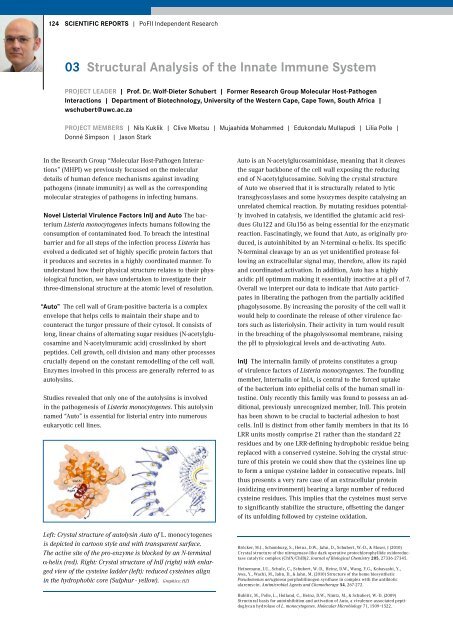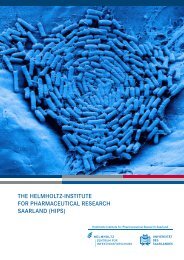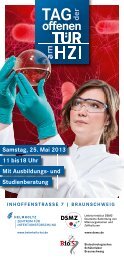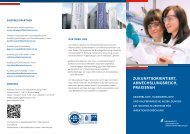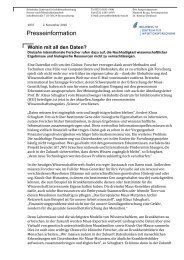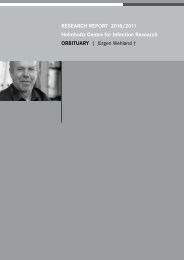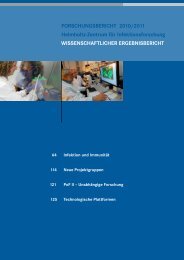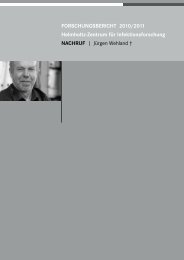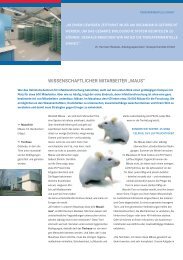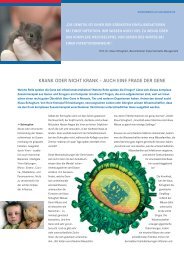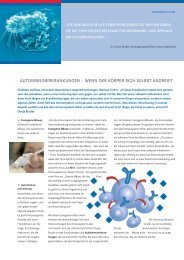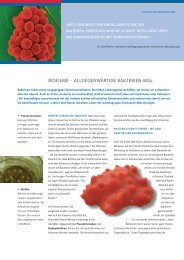Research Report 2010 2011 - Helmholtz-Zentrum für ...
Research Report 2010 2011 - Helmholtz-Zentrum für ...
Research Report 2010 2011 - Helmholtz-Zentrum für ...
You also want an ePaper? Increase the reach of your titles
YUMPU automatically turns print PDFs into web optimized ePapers that Google loves.
124 SCIENTIFIC REPORTS | PoFII Independent <strong>Research</strong><br />
03 Structural Analysis of the Innate Immune System<br />
PROJECT LEADER | Prof. Dr. Wolf-Dieter Schubert | Former <strong>Research</strong> Group Molecular Host-Pathogen<br />
Interactions | Department of Biotechnology, University of the Western Cape, Cape Town, South Africa |<br />
wschubert@uwc.ac.za<br />
PROJECT MEMBERS | Nils Kuklik | Clive Mketsu | Mujaahida Mohammed | Edukondalu Mullapudi | Lilia Polle |<br />
Donné Simpson | Jason Stark<br />
In the <strong>Research</strong> Group “Molecular Host-Pathogen Interactions”<br />
(MHPI) we previously focussed on the molecular<br />
details of human defence mechanisms against invading<br />
pathogens (innate immunity) as well as the corresponding<br />
molecular strategies of pathogens in infecting humans.<br />
Novel Listerial Virulence Factors InlJ and Auto The bacterium<br />
Listeria monocytogenes infects humans following the<br />
consumption of contaminated food. To breach the intestinal<br />
barrier and for all steps of the infection process Listeria has<br />
evolved a dedicated set of highly specific protein factors that<br />
it produces and secretes in a highly coordinated manner. To<br />
understand how their physical structure relates to their physiological<br />
function, we have undertaken to investigate their<br />
three-dimensional structure at the atomic level of resolution.<br />
“Auto” The cell wall of Gram-positive bacteria is a complex<br />
envelope that helps cells to maintain their shape and to<br />
counteract the turgor pressure of their cytosol. It consists of<br />
long, linear chains of alternating sugar residues (N-acetylglucosamine<br />
and N-acetylmuramic acid) crosslinked by short<br />
peptides. Cell growth, cell division and many other processes<br />
crucially depend on the constant remodelling of the cell wall.<br />
Enzymes involved in this process are generally referred to as<br />
autolysins.<br />
Studies revealed that only one of the autolysins is involved<br />
in the pathogenesis of Listeria monocytogenes. This autolysin<br />
named “Auto” is essential for listerial entry into numerous<br />
eukaryotic cell lines.<br />
Left: Crystal structure of autolysin Auto of L. monocytogenes<br />
is depicted in cartoon style and with transparent surface.<br />
The active site of the pro-enzyme is blocked by an N-terminal<br />
α-helix (red). Right: Crystal structure of InlJ (right) with enlarged<br />
view of the cysteine ladder (left): reduced cysteines align<br />
in the hydrophobic core (Sulphur - yellow). Graphics: HZI<br />
Auto is an N-acetylglucosaminidase, meaning that it cleaves<br />
the sugar backbone of the cell wall exposing the reducing<br />
end of N-acetylglucosamine. Solving the crystal structure<br />
of Auto we observed that it is structurally related to lytic<br />
transglycosylases and some lysozymes despite catalysing an<br />
unrelated chemical reaction. By mutating residues potentially<br />
involved in catalysis, we identified the glutamic acid residues<br />
Glu122 and Glu156 as being essential for the enzymatic<br />
reaction. Fascinatingly, we found that Auto, as originally produced,<br />
is autoinhibited by an N-terminal α-helix. Its specific<br />
N-terminal cleavage by an as yet unidentified protease following<br />
an extracellular signal may, therefore, allow its rapid<br />
and coordinated activation. In addition, Auto has a highly<br />
acidic pH optimum making it essentially inactive at a pH of 7.<br />
Overall we interpret our data to indicate that Auto participates<br />
in liberating the pathogen from the partially acidified<br />
phagolysosome. By increasing the porosity of the cell wall it<br />
would help to coordinate the release of other virulence factors<br />
such as listeriolysin. Their activity in turn would result<br />
in the breaching of the phagolysosomal membrane, raising<br />
the pH to physiological levels and de-activating Auto.<br />
InlJ The internalin family of proteins constitutes a group<br />
of virulence factors of Listeria monocytogenes. The founding<br />
member, Internalin or InlA, is central to the forced uptake<br />
of the bacterium into epithelial cells of the human small intestine.<br />
Only recently this family was found to possess an additional,<br />
previously unrecognized member, InlJ. This protein<br />
has been shown to be crucial to bacterial adhesion to host<br />
cells. InlJ is distinct from other family members in that its 16<br />
LRR units mostly comprise 21 rather than the standard 22<br />
residues and by one LRR-defining hydrophobic residue being<br />
replaced with a conserved cysteine. Solving the crystal structure<br />
of this protein we could show that the cysteines line up<br />
to form a unique cysteine ladder in consecutive repeats. InlJ<br />
thus presents a very rare case of an extracellular protein<br />
(oxidizing environment) bearing a large number of reduced<br />
cysteine residues. This implies that the cysteines must serve<br />
to significantly stabilize the structure, offsetting the danger<br />
of its unfolding followed by cysteine oxidation.<br />
Bröcker, M.J., Schomburg, S., Heinz, D.W., Jahn, D., Schubert, W.-D., & Moser, J (<strong>2010</strong>)<br />
Crystal structure of the nitrogenase-like dark operative protochlorophyllide oxidoreductase<br />
catalytic complex (ChlN/ChlB)2. Journal of Biological Chemistry 285, 27336-27345.<br />
Heinemann, I.U., Schulz, C., Schubert, W.-D., Heinz, D.W., Wang, Y.G., Kobayashi, Y.,<br />
Awa, Y., Wachi, M., Jahn, D., & Jahn, M. (<strong>2010</strong>) Structure of the heme biosynthetic<br />
Pseudomonas aeruginosa porphobilinogen synthase in complex with the antibiotic<br />
alaremycin. Antimicrobial Agents and Chemotherapy 54, 267-272.<br />
Bublitz, M., Polle, L., Holland, C., Heinz, D.W., Nimtz, M., & Schubert, W.-D. (2009)<br />
Structural basis for autoinhibition and activation of Auto, a virulence-associated peptidoglycan<br />
hydrolase of L. monocytogenes. Molecular Microbiology 71, 1509–1522.


